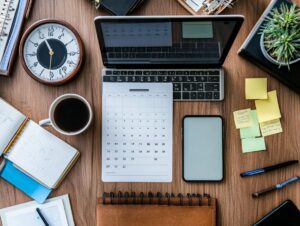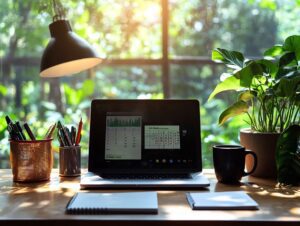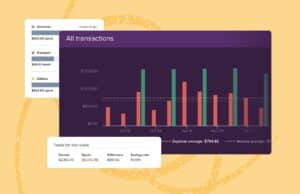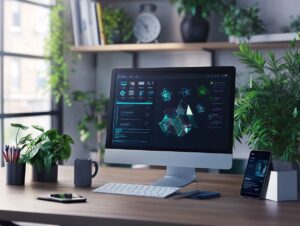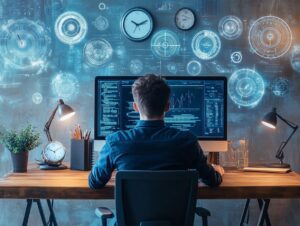With our lives as busy as they are, learning how to get more done has become increasingly important. Whether you are balancing multiple responsibilities at work or managing personal tasks, understanding productivity and how to enhance it can significantly improve daily routines. Effective time management and focus can play a key role in this process.
This article delves into key concepts such as identifying common distractions, exploring effective time management strategies, and employing techniques to maximize focus and energy. It also discusses how to create a conducive workspace and utilize technology and collaborative tools to streamline tasks and enhance efficiency.
Prepare to unlock your full potential!
Understanding Productivity to Get More Done

Understanding productivity is essential for achieving success in both personal and professional realms. It involves various components such as time management, effective planning, and the ability to concentrate on tasks that align with your goals. Task prioritization and goal setting are crucial aspects of this understanding.
In our fast-paced world, mastering productivity has become increasingly important, as it directly affects efficiency, performance levels, and task management in the workplace.
By gaining a clear understanding of what productivity entails, individuals can implement strategies that enhance their workflow and ultimately lead to improved outcomes.
Defining Productivity and its Importance
Productivity is often regarded as a measure of efficiency in completing tasks and achieving goals, which is essential for both personal growth and organizational success. It is influenced by factors such as motivation, delegation, and planning.
It involves not only the speed at which tasks are completed but also the quality of the outcomes produced within that timeframe. In our increasingly fast-paced world, enhancing productivity can significantly improve time management and overall performance. Employing strategic planning and self-discipline can greatly contribute to these improvements.
This concept is closely tied to goal setting, as having clear objectives can steer individuals toward more focused efforts. Motivation and self-motivation are also crucial factors in maintaining high levels of productivity; when individuals are inspired by their aspirations, their ability to produce quality work tends to increase.
Ultimately, fostering a productive mindset helps individuals strike a balance between various aspects of life, including professional responsibilities and personal aspirations. This balance aids in achieving a sustainable work-life balance and enhances overall well-being.
Identifying Time Wasters
Identifying time wasters is an essential step toward enhancing overall productivity and achieving goals more efficiently. Distractions, ranging from social media notifications to unnecessary meetings, can significantly affect focus, leading to procrastination and missed deadlines. Effective communication and active listening can help mitigate some of these distractions.
By recognizing these time-wasting habits, individuals can take proactive measures to eliminate them from their daily routines. This approach not only allows for improved time management but also fosters greater efficiency and better results in both professional and personal settings.
Common Distractions and How to Avoid Them
Common distractions in our daily lives can significantly hinder our ability to focus and manage time effectively, ultimately affecting our productivity levels and engagement.
These distractions can vary widely, from the incessant pings of smartphone notifications to the enticing pull of social media. Additionally, there is the background noise of a busy office or the various household chores that can tempt us when working from home.
To address these interruptions, it may be beneficial to implement specific strategies. For instance, creating a designated workspace, utilizing applications that block distracting websites during work hours, or scheduling focused time blocks with brief breaks in between can help maintain energy levels. Additionally, using mindfulness techniques can reduce cognitive load and improve concentration.
By adopting these productivity techniques, individuals may notice an improvement in their ability to concentrate, enabling them to manage tasks more efficiently and enhance their overall work output. Regular self-assessment can also help in continually optimizing these techniques.
Effective Time Management Strategies To Get More Done
Effective time management strategies play a crucial role in maximizing productivity and reaching both short-term and long-term goals. These strategies require careful planning, prioritization of tasks, and a structured approach to handling your workload. Employing techniques like the Pomodoro Technique and time blocking can be particularly effective.
By employing techniques such as time blocking, scheduling, and using planning tools, you can greatly enhance your efficiency and organization. Mastering these strategies not only boosts your performance but also helps you maintain a balanced work-life dynamic. Additionally, delegation can play a critical role in managing your workload effectively.
Tips for Prioritizing and Organizing Tasks
Prioritizing and organizing tasks effectively can significantly enhance productivity, allowing individuals to concentrate on what truly matters.
By employing techniques such as checklists, automation, and productivity applications, one can streamline their workload and alleviate stress. Creating daily or weekly checklists provides a visual representation of tasks to be accomplished, offering a clearer perspective on priorities. Using to-do lists and planning methods like SMART goals can further enhance task organization.
Automation is particularly beneficial, as it saves valuable time by managing repetitive tasks, thus enabling individuals to focus on higher-level responsibilities. Additionally, productivity apps come equipped with features like deadline reminders and progress tracking, which facilitate staying on course. Implementing resource allocation techniques can also aid in efficient task management.
By embracing these strategies, individuals can achieve more efficient time management, ultimately leading to greater success in reaching their goals and improving performance.
Maximizing Focus and Energy to Get More Done
Maximizing focus and energy is crucial for enhancing productivity, as it enables individuals to work efficiently and maintain high levels of concentration throughout their tasks. Managing your energy effectively, through proper breaks and self-care practices, can help maintain productivity over long periods.
It is important to identify the factors that can contribute to burnout and to learn how to manage energy effectively. Techniques such as mindfulness, taking regular breaks, and cultivating a positive mindset can greatly improve one’s ability to concentrate and sustain productivity in both personal and professional settings. Engaging in self-reflection and adopting healthy work habits are also essential practices.
Ways to Improve Concentration and Avoid Burnout
Improving concentration is crucial for enhancing productivity and can play a significant role in preventing burnout, especially in high-pressure work environments. Effective energy management and time tracking can help maintain high levels of concentration.
One effective method to achieve better focus is the Pomodoro Technique. This approach involves working in concentrated bursts of approximately 25 minutes, followed by brief breaks. This not only boosts concentration but also provides opportunities for mental recovery, which helps to mitigate the risk of exhaustion.
Additionally, establishing a prioritized task list can greatly streamline workflow. By tackling important tasks first, individuals can maintain focus and stay organized. Techniques like critical thinking and ongoing learning can further enhance task management capabilities.
Incorporating healthy work habits such as regular physical activity and mindful breathing exercises can also significantly aid in sustaining concentration. Regular evaluation and feedback can help in fine-tuning these habits for better productivity.
Furthermore, creating a designated workspace that is free from distractions fosters a more supportive environment for productivity, enabling one to navigate busy days with clarity and purpose. Ensuring proper workplace ergonomics can also contribute to a more effective work environment.
Creating a Productive Environment
Establishing a productive environment is essential for improving efficiency and sustaining high levels of focus and motivation within your workspace. Simplifying your workspace layout and ensuring a clutter-free zone can significantly enhance your ability to concentrate.
By carefully considering the layout, organization, and overall atmosphere, you can create a setting that fosters productivity and encourages optimal performance. Regular assessment and improvement of your work environment can ensure it remains conducive to high productivity.
Optimizing Your Workspace and Minimizing Distractions
Optimizing your workspace is crucial for enhancing productivity and reducing distractions that may impede your focus. This involves strategic planning and a clear assessment of what elements contribute to a productive environment.
To create an efficient environment, start by decluttering your desk and organizing essential tools, as this can significantly improve your concentration. It may be beneficial to incorporate storage solutions, such as drawer organizers or filing cabinets, to keep papers and supplies neatly arranged. Additionally, utilizing productivity tools like time management apps or digital task lists can streamline your workflow, making it much easier to maintain focus. Implementing proper resource allocation can further optimize your workspace.
Employing techniques such as the Pomodoro Technique can also help in effectively managing work sessions and break intervals. Ultimately, a well-structured workspace gives individuals the power to perform at their best and cultivates a productive mindset. Regular brainstorming sessions can also enhance creativity and innovation in your work environment.
Utilizing Technology for Efficiency to Get More Done
Effectively utilizing technology can significantly transform the way one approaches tasks, leading to improved efficiency and enhanced productivity in both personal and professional endeavors. Leveraging tools and apps designed for task management can streamline your workflow and improve results.
Tools and Apps to Streamline Tasks and Increase Productivity
There are a variety of tools and applications available that can help streamline tasks and significantly enhance productivity by optimizing your workflow. These tools can simplify complex processes and improve performance metrics.
These resources address different aspects of task management, enabling users to prioritize their responsibilities effectively and track their progress with ease. For example, project management platforms such as Trello and Asana offer visual boards and task lists that promote collaboration among team members. Additionally, time-tracking applications like Toggl and Clockify help individuals manage their schedules more effectively, ensuring they operate at peak efficiency. Tools that facilitate ongoing learning and adaptability can further enhance productivity.
Note-taking tools like Evernote or Notion facilitate the seamless organization of thoughts and ideas, greatly supporting the creative process and task management. Furthermore, automation utilities such as Zapier can connect various applications, minimizing repetitive tasks and allowing users to concentrate on what truly matters in their work, thereby enhancing efficiency and productivity.
Frequently Asked Questions
How to get more work done: Top 6 FAQs
1. Why do I struggle to get more work done?
There could be various reasons for this, such as lack of motivation, poor time management, or being overwhelmed with tasks. Assessing your work habits, such as task prioritization and energy management, can help identify the root cause and address it accordingly.
2. How can I increase my productivity?
One effective way to increase productivity is by setting clear and achievable goals, such as SMART goals. Break down tasks into smaller chunks and prioritize them. This will help you stay focused, motivated, and manage your cognitive load more effectively.
3. How does procrastination affect my ability to get work done?
Procrastination can be a major hindrance to getting work done. It leads to a buildup of tasks, stress, and eventually affects the quality of your work. Addressing this habit through techniques like the Pomodoro technique or time blocking can help overcome it and improve your concentration.
4. Should I multitask to get more work done?
Contrary to popular belief, multitasking can actually decrease productivity and increase cognitive load. It’s better to focus on one task at a time and give it your full attention. This will allow you to work more efficiently and produce better results while maintaining mental clarity.
5. How can I manage my time better to get more work done?
Time management is crucial for getting more work done. Start by creating a schedule or to-do list, and stick to it. Implementing planning methods such as time blocking or to-do lists can help prioritize important tasks and eliminate distractions, enhancing your overall productivity.
6. Can technology help me get more work done?
Yes, there are various productivity tools and apps that can help you manage your tasks, track your progress, and eliminate distractions. Tools like task automation apps can streamline your workflow. However, it’s important to use them wisely and not let them become a source of distraction themselves, ensuring you maintain mental clarity and focus.




